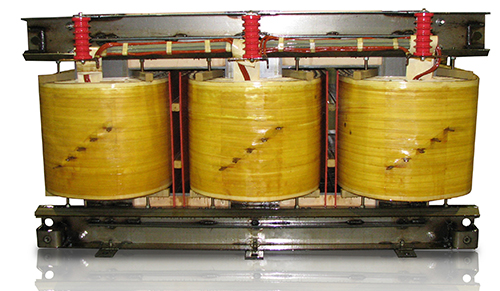 Transformers use electromagnetic induction to allow a change in voltage between their primary and secondary components. When an alternating current (AC) is applied to the primary coil, a differing magnetic field is created, which induces a voltage across the secondary coil. This enables the transformer to essentially couple the AC input from its primary component to its second part. However, transformers do not allow direct current (DC) input, as this would cause no change in current and, therefore, no changing magnetic field to induce a voltage across the secondary component.
Transformers use electromagnetic induction to allow a change in voltage between their primary and secondary components. When an alternating current (AC) is applied to the primary coil, a differing magnetic field is created, which induces a voltage across the secondary coil. This enables the transformer to essentially couple the AC input from its primary component to its second part. However, transformers do not allow direct current (DC) input, as this would cause no change in current and, therefore, no changing magnetic field to induce a voltage across the secondary component.
How Transformers Work
A transformer is a common electrical device that uses electromagnetic induction to send an alternating current (AC) from one circuit to another, often changing the voltage and electric current in the process. Transformers do not pass direct current (DC), instead using an AC voltage to create a magnetic field to create a voltage across the secondary component. This allows it to be used in the electrical grid, where transformers are used for stepping up or down voltages, reducing the energy lost in electrical transmission. Additionally, transformers are also used as part of devices such as current transformers.
Transformers require inputs of high electrical energy in order to operate. This is because to achieve the desired voltage transformation, a higher energy level must be input into the primary coil to create a strong magnetic field. This strong magnetic field is then passed through to the secondary component, inducing a voltage across it and allowing the transformer to effectively couple the AC input from its primary component to its secondary component. The higher the energy level at the primary, the stronger the induced voltage across the secondary.
Transformers are able to change voltage by utilizing the common thread between the ratio of loops of wire in the primary winding to the secondary winding and the ratio of the primary voltage to the output voltage. This is known as the turn ratio and is at the heart of how transformers work. The higher this ratio, the more voltage will be stepped down, while a lower ratio will result in a higher output voltage. Transformers use electromagnetic induction to take an alternating current (AC) signal from one electric circuit and transform it into another circuit with a different voltage level. By carefully controlling this turns ratio, transformers can effectively alter or "transform" voltages as needed in order to reduce energy loss during transmission or other applications.
Efficiency
Transformers are a required part of the power grid, used to maintain voltage and efficiency by transferring alternating current (AC) signals from one electric circuit to another with a different voltage. The ratio between the number of loops in the primary coil and the number of loops in the secondary coil, called the turns ratio, dictates how much voltage is stepped down or up. With careful control of this ratio, transformers can effectively change voltages as needed in order to reduce energy loss during transmission or other applications. High-power transformers reach efficiency levels as high as 99%. However, some losses will always exist due to transformer impedance. To learn more about transformers, please contact us.
Contact Us Today
Don't settle for inefficient or outdated power distribution methods. Becker Mining's industrial transformers are the smart choice for industries looking to maximize efficiency and safety. Get in touch today to discover how our transformers can help you reach your objectives and take your business to new heights.
Products We Offer:
- Explosion Proof Equipment
- Transformers
- Arc Guard
- Longwall Electrical Systems
- Capacitor Trip Devices
- Electrical Equipments like capacitor banks, switch houses, junction, and splice boxes.
Power up your productivity with Becker Mining's transformers - the reliable and efficient solution for all your power distribution needs.